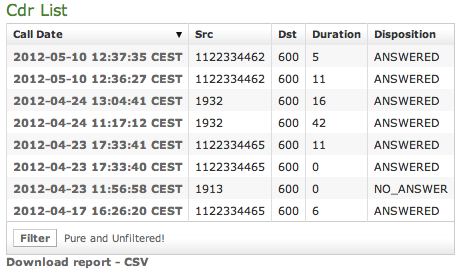There are several kind of logs on PrivateServer:
- SIP activity logs
- Registered Accounts
- Web Authorization accesses
- Call Detailed Records
Each one is suitable to monitor a different part of the service.
4.0.1 SIP activity logs
The SIP Sessions page show the activities each Account did with the server.
| Subtitle | ||||||
|---|---|---|---|---|---|---|
| ||||||
To get this list just click on the SIP Sessions entry in the main menu. The activities are listed by date and they give you a detailed overview of the SIP status for each one. These logs are very useful for debugging the networking issues on the client side.
In figure
| Xref | ||
|---|---|---|
|
The Event column lists the SIP events:
- CONNECT: PrivateGSM client opened a connection to PrivateServer. This usually means the client has been activated
- REGISTER: The Account has been correctly registered and is now on line
- UNREGISTER: The Account has been correctly unregistered and is now off line
- DISCONNECT: PrivateGSM client closed the connection. This usually means the client has been stopped.
4.0.2 Registered Accounts
If you want a full list of all the Accounts who are on line, then you click on the Registered Accounts entry in the main menu.
| Subtitle | ||||||
|---|---|---|---|---|---|---|
| ||||||
The list shows all the user actually on line and thus reachable on your PrivateServer. To read more detail about each user just click on its Id.
4.0.3 Web Authorization accesses
You can have a full view of all the access made to the management console.
Just click on the Web Sessions entry in the main menu and you get a list as in figure above. It shows up the detail about the user (principal), the IP address used to connect, the date of each authentication and the outcome (Event Type).
4.0.4 Call Detailed Records
Despite its name the CDR is a debugging and quality assurance facility. It saves all the calls status, meaning it is very useful to understand is something is going wrong with you Secure Call Service.
To access the CDR you must click on the Call Detailed Record in the main menu. You'll get the "Cdr List" page which includes all the calls recorded.
| Subtitle | ||||||
|---|---|---|---|---|---|---|
| ||||||
If the table is empty, please place a phone call between the two SIp Accounts. Then come back on the page and check that the call has been correctly registered. The shown fields are:
- Call Data: when the call has been placed
- Src: which SIP Account called
- Duration: how long the call lasted
- Disposition: which result the call had
The Disposition is very important because it tells you the exit code of each call. Possible codes are:
- ANSWERED: the call was taken by the callee
- NO_ANSWER: nobody picked up the phone to answer (mostly this is a time out code)
- BUSY: the callee refused the call
- FAILED: for some reason the call was not able to be placed



